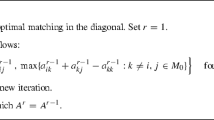Abstract
The lexicographic kernel of a game lexicographically maximizes the surplusses s ij (rather than the excesses as would the nucleolus) and is contained in both the least core and the kernel. We show that an element in the lexicographic kernel can be computed efficiently, provided we can efficiently compute the surplusses s ij (x) corresponding to a given allocation x. This approach improves the results in Faigle et al. (in Int J Game Theory 30:79–98, 2001) and allows us to determine a kernel element without appealing to Maschler transfers in the execution of the algorithm.
Similar content being viewed by others
References
Davis M, Maschler M (1965) The kernel of a cooperative game. Naval Logistics Quaterly 12 (1965), 223–259
Faigle U, Fekete SP, Hochstättler W, Kern W (1997) On the complexity of testing core membership for min cost spanning tree games. Int J Game Theory 26:361–366
Faigle U, Kern W, Kuipers J (2001) On the computation of the nucleolus of a cooperative game. Int J Game Theory 30:79–98
Faigle U, Kern W, Still G (2002) Algorithmic principles of mathematical programming. Kluwer, Dordrecht
Justman M(1977) Iterative processes with “nucleolar” restrictions. Int J Game Theory 6: 189–212
Kern W, Paulusma D (2003) Matching games: the least core and the nucleolus. Math Oper Res 28:294–308
Maschler M, Peleg B (1975) Stable sets and stable points of set valued dynamic systems with applications to game theory. SIAM J Control Optim 14:985–995
Megiddo N (1987) Computational complexity of the game theory approach to cost allocation for a tree. Math Oper Res 3:89–196
Schmeidler D (1969) The nucleolus of a characteristic function game. SIAM J Appl Math 17:1163–1170
Schrijver A (1986) Theory of linear and integer programming. Wiley, Newark
Schrijver A (2006) A combinatorial algorithm for minimizing submodular functions in strongly polynomial time. J Comb Theory B80:346–355
Stearns RE (1968) Convergent transfer schemes for n-person games. Trans Am Math Soc 134:449–459
Yarom M (1981) The lexicographic kernel of a cooperative game. Math Oper Res 6:88–100
Author information
Authors and Affiliations
Corresponding author
Additional information
We thank the referees for clarifying the presentation of the proof of Proposition 2.1.
Rights and permissions
About this article
Cite this article
Faigle, U., Kern, W. & Kuipers, J. Computing an Element in the Lexicographic Kernel of a Game. Math Meth Oper Res 63, 427–433 (2006). https://doi.org/10.1007/s00186-006-0065-5
Received:
Accepted:
Published:
Issue Date:
DOI: https://doi.org/10.1007/s00186-006-0065-5




